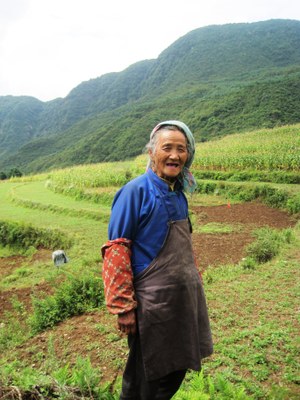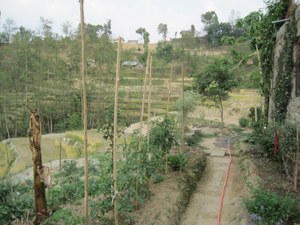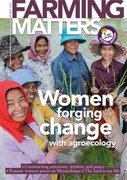In the Himalayas, male outmigration and the effects of climate change create challenges for rural women. Many of them develop innovative farming practices based on agroecology, push alternative economies and create niche markets. Women in India, Nepal and China show how agroecology can be a strategy to adapt to changing circumstances, and to drive positive social change.

Young men from even the remotest places in the Himalayan mountains are leaving their homes in search of income opportunities elsewhere. This trend of out-migration has been driven by increased mobility and access to information, in combination with the effects of climate change, including both increased flooding and drought. Drought and erratic rain hamper rain-fed farming in the region. Floods destroy cultivated fields by sand-casting, sweeping away seed and food stocks and killing livestock. Families do not see agricultural investments as viable anymore and for farmers who mostly have agricultural skills the best option seems to migrate. When men leave, they abandon the farms and lose interest in agriculture while their families stay behind. Women are therefore faced with challenges to produce food without the labour of their husbands. This case illustrates the innovative capacity of women, not only to adapt to changing circumstances, but also to drive positive social change through agroecology.
Traditionally both women and men shaped the way farming was done in the Himalayas. The male household heads would choose the cash crops, the livestock and also decide on innovations. Women would make decisions about farming for household consumption such as the home gardens and small livestock. Women are not allowed to plough but do other work such as planting, weeding or firewood and fodder collection.
Navigating environmental stress
Out-migration of men challenges women to get tasks done that are traditionally for men, such as ploughing. Remittances are often not enough to enable the women to hire labourers and compensate the lack of labour on the farm. Many engage in share-cropping arrangements, while others abandon the land and try to find alternative jobs so that they can buy their staple foods. In very rare cases in Nepal, women who trespassed cultural boundaries, have learnt how to plough and were seen on their fields behind their two oxen.
In addition to the increased workload for women in the absence of men, women have to deal with climate change related disasters for which they are often unprepared. This is harder for them since women do not have the same access as men do to markets, extension services or alternative livelihood options that could help them respond to climate stress. Their access is restricted by limited mobility and other cultural constraints. Recent field research produced interesting examples from the region that showed how under environmental stress women who live in villages that suffer from male outmigration develop new farming practices, push alternative economies and create niche markets. Here are three examples from India, Nepal and China.
Sharing resources in Assam, Northeast India
In the district Tinsukia, at the river bank of the Brahmaputra River in India, annual floods regularly damage agricultural crops. The farmers managed to adapt to the floods with diversification in crops and livestock as well as sharecropping arrangements. However, in 2012 a big flood caused colossal damage to infrastructure, livestock and crop and agricultural land. Many of the households that reported sand casting on their farmland assessed that they would not be able to cultivate the affected land for the next two to five years.
Women’s response to the flood was a system called bhagi, which included sharing of small livestock, handicraft skills and land by engaging in sharecropping. For example, one family borrowed a pair of chicken from their neighbours and took the responsibility of their daily care on the condition that when young chicks were born, they would be divided equally between the lending and borrowing families. Women also initiated other forms of bartering such as exchanging their weaving skills in exchange for material. Women pushed their families to engage in share-cropping arrangements, where the land owning family invests in all external inputs including tractor, seed, fertilizers, pesticides and irrigation while the working family puts in labour. The harvest is then shared equally between the two families.
In this way women relieved themselves of some additional responsibility and workload that came with the floods and still ensured good care of their families. In migrant households, where remittances are not enough to compensate for the lack of labour on the farm, such arrangements became extremely important.
Switching to fruit trees in Central Nepal

In Kavre District in Nepal where outmigration of men is high and rain patterns are erratic, farmers founded cooperatives to facilitate organic vegetable production and rain water harvesting. This was supported by the Appropriate Agriculture Alternatives training centre. The produce was bought at fixed rates and sold in Kathmandu markets.
However, because of an increased number of households without a male household head , the training centre extended its activities to promoting fruit and nut trees such as almond or macademia which need less water than vegetables. It was accompanied by trainings in biointensive farming, extension work with local communities and research with regard to new varieties that could suit the Nepali context.
Several women were interested in growing fruit trees to increase their income and secure their livelihoods because of fluctuating remittances from their husbands or sons. However, there were two major obstacles. First, the initial investment into trees is high and it takes several years before income can be achieved. Second, some elderly in the area believe that trees should not be transplanted from one place to another. This is a cultural and social barrier to innovation. However, a couple of the families managed to convince their elders and are now trying out the tree varieties as a new income source that helps them to ensure their food security in an unfavourable climate.
Growing herbs in Yunnan Province, China
Towards the other side of the Himalayas, in the Yunnan Province of China, drought is a major problem for the farmers. In the small village of Weng Mu, a few hours North of Kunming, which is dominated by the Yi, one of the many ethnic minorities of the province, drought hampered the rain-fed crop production of wheat, maize and potato. Several elderly women, encouraged by an emerging small-scale processing industry of medicinal herbs, began planting of maka (Lepidium meyenii) as a new livelihood source. It is used for culinary and medicinal purposes enhancing energy, stamina and fertility.
They have been cultivating maka for 2-3 years now and in some cases up to half of their land is occupied with the medicinal plant, which not only gets them a good market price, but needs little care and is more resistant to water stress. The women use seed from small scale seed saving and exchange initiatives in the area. Despite the higher dependency on markets, they are proud that they triggered the changes in farming and are able to support their families.
Women as innate innovators
These examples show successful experiences of women coping with climate stress and outmigration of men, at the same time improving their autonomy, ensuring their food security and reducing hard labour. They do not only show that women are able to develop successful coping strategies but it also becomes clear that women are innate innovators. Gender roles are changing as part of the social transformation in the region. Women start experimenting and try out new ways of farming when pushed to the wall in the context of environmental stress and migration. These innovations sometimes require breaking though cultural barriers as in the case from Nepal.
For the most part, however, women have not gained much with respect to power relations. Decisions on farm management, field and cash crops or livestock are still mostly taken by men (be it from a distance or by male relatives). These decisions are often based on economic considerations only, while women tend to take into account social, cultural, nutritional and other factors in their decisions. However it appears that the more gender roles change, the more can women utilise new spaces and opportunities, become innovators and overcome challenges step by step.
Sarah Marie Nischalke
Sarah Marie Nischalke is Senior Researcher at the Center for Development Research, Bonn, Germany. The research on which this article is based was conducted as part of her former position in the Himalayan Climate Change Adaptation Program at the International Center of Integrated Mountain Development (snischal@uni-bonn.de).

